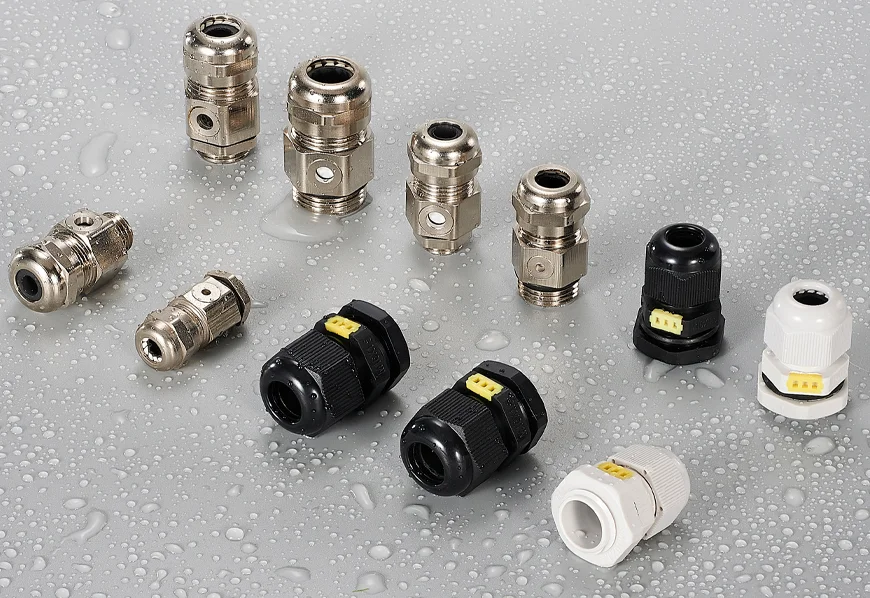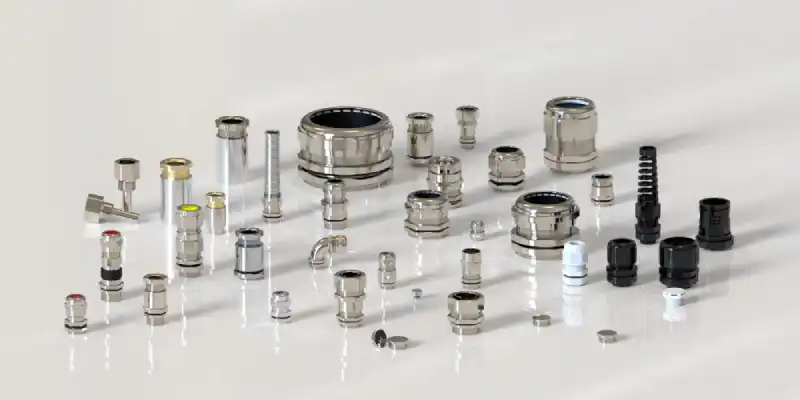تمثل غدد الكابلات القابلة للتنفس وغدد الكابلات القياسية حلين متميزين لإدارة الكابلات في الأنظمة الكهربائية، كل منهما مصمم لمعالجة تحديات بيئية محددة. بينما يخدم كلاهما الغرض الأساسي من تأمين الكابلات وتوفير الحماية البيئية، تختلف فلسفات التصميم وآليات التشغيل وسياقات التطبيق اختلافًا كبيرًا. يقدم هذا التقرير مقارنة تقنية شاملة، مستفيدًا من علوم المواد ومبادئ الهندسة الميكانيكية وبيانات التطبيقات الصناعية لتوضيح خصائصها الفريدة وحالات الاستخدام الأمثل.
التصميم الأساسي والبناء الأساسي
غدد الكابلات القابلة للتنفس
تدمج غدد الكابلات القابلة للتنفس غشاء تنفيس - يتكون عادةً من بولي تترافلوروإيثيلين الموسع (ePTFE) - في تصميمها. يسمح هذا الغشاء الصغير الذي يسهل اختراقه بمرور جزيئات الهواء والبخار مع حجب السوائل والغبار والملوثات، مما يحقق تصنيف IP68 المقاوم للماء. يشتمل هيكل الغدة على:
- الجسم والصمولة: مصنوع من النحاس المطلي بالنيكل أو النايلون PA66 لمقاومة التآكل والمتانة.
- مكونات الختم: تضمن موانع تسرب مطاط البولي كلوروبرين والنتريل (CR/NBR) وإدخالات التثبيت المصنوعة من البولي أميد الاحتفاظ بالكابل وإحكام إغلاقه بإحكام.
- الإدارة الحرارية: يعمل غشاء ePTFE على تسهيل تبديد الحرارة مع معادلة فروق الضغط الداخلي والخارجي الناتجة عن تقلبات درجات الحرارة.
غدد الكابلات القياسية
تعطي الغدد الكبلية القياسية الأولوية للاحتفاظ الميكانيكي والعزل البيئي الأساسي. ويفتقر تصميمها إلى ميزات معادلة الضغط، مع التركيز بدلاً من ذلك على:
- آليات ضغط مفردة أو مزدوجة: هذه الأغلفة والعوازل الآمنة للكابلات.
- التنوع المادي: تشمل المتغيرات المتاحة النحاس الأصفر أو الفولاذ المقاوم للصدأ أو النايلون والغدد المصفحة أو المقاومة للانفجار.
- ختم مبسط: تعتمد على حشوات مطاطية أو حلقات على شكل حرف O للحماية من الدخول بدون قدرات تهوية نشطة.
ويتمثل الفرق الهيكلي الرئيسي في أن الغدد القابلة للتهوية تتضمن غشاء تنفيس لتدفق الهواء، بينما لا تتضمن الغدد القياسية ذلك.
الشركة المصنعة لغدات الكابلات المخصصة
الأداء الوظيفي
معادلة الضغط وتخفيف التكثيف
تتفوق غدد الكابلات القابلة للتنفس في البيئات المعرضة للتكثيف. تعمل أغشية ePTFE الخاصة بها على موازنة فروق الضغط لمنع تراكم الرطوبة، مما يقلل من خطر التآكل أو الأعطال الكهربائية. على سبيل المثال، في إضاءة LED المعرضة لتقلبات درجات الحرارة، تقلل الغدد القابلة للتنفس من الرطوبة بنسبة 60-80% مقارنةً بالأنظمة محكمة الغلق.
من ناحية أخرى، تنشئ الغدد القياسية مانعات تسرب ثابتة تحبس الرطوبة الداخلية، مما يستلزم حلولاً مساعدة مثل حزم المجففات أو فتحات التنقيط في التجهيزات المعرضة للتكثيف.
مقاييس حماية البيئة
- تقييمات IP: يحقق كلا نوعي الغدد حماية IP68، ولكن الغدد القابلة للتنفس تحافظ على هذا التصنيف مع السماح بتدفق الهواء.
- المرونة في درجات الحرارة: تعمل الغدد القابلة للتنفس من -40 درجة مئوية إلى 120 درجة مئوية، مما يدعم تبديد الحرارة. تطابق الغدد القياسية هذا النطاق ولكنها تفتقر إلى التنظيم الحراري المتكامل.
- المتانة الميكانيكية: تتحمل الغدد القياسية ذات الضغط المزدوج قوى السحب المحورية الأعلى مقارنةً بالنماذج القابلة للتنفس، والتي تركز على أداء الغشاء.
سياقات التطبيق
غدد الكابلات القابلة للتنفس
- صناعات الصمامات الثنائية الباعثة للضوء والطاقة الشمسية: منع التعفير في وحدات الإنارة وصناديق التوصيل.
- الاتصالات الخارجية: تخفيف دخول الرطوبة في حاويات 5G مع موازنة التنظيم الحراري.
- البحرية والبحرية: توفير مقاومة المياه المالحة ومعادلة الضغط في البيئات القاسية.
غدد الكابلات القياسية
- الأتمتة الصناعية: توصيلات محرك آمن في البيئات الداخلية الخاضعة للرقابة.
- المناطق الخطرة: تمنع المتغيرات المقاومة للانفجار دخول الغاز في مصانع البتروكيماويات.
- مراكز البيانات: تحمي الغدد المصفحة كابلات الألياف الضوئية في صواني الكابلات.
اعتبارات التركيب والصيانة
الغدد القابلة للتنفس
- مناولة الغشاء: تجنّب ثقب غشاء ePTFE؛ يوصى باستخدام أدوات ملساء الفك.
- بروتوكولات التنظيف: يضمن الفحص الدوري أداءً قابلاً للتنفس، مع استخدام كحول الأيزوبروبيل للتنظيف.
- توافق الكابل: الأنسب للكابلات ذات الغلاف الأملس بدلاً من الأنواع المموجة أو المدرعة.
الغدد القياسية
- ضبط الضغط: يتطلب عزم دوران دقيق لمنع تلف غلاف الكابل.
- الاقتران البيئي: اختيار المواد المناسبة، مثل الفولاذ المقاوم للصدأ للمصانع الكيميائية، أمر بالغ الأهمية.
المقايضات الاقتصادية والتشغيلية
| العامل | الغدد القابلة للتنفس | الغدد القياسية |
|---|---|---|
| التكلفة | 30-50% أعلى بسبب غشاء ePTFE | تكلفة مقدمة أقل |
| العمر الافتراضي | أكثر من 10 سنوات مع سلامة الأغشية | أكثر من 15 عامًا في البيئات غير المسببة للتآكل |
| كفاءة الطاقة | يقلل من الحاجة إلى أنظمة التهوية النشطة | قد يتطلب إزالة الرطوبة الإضافية |
| التعديل التحديثي | متوافق مع العبوات الموجودة | يقتصر على التطبيقات التي لا تحتوي على تكاثف |
الختام
تمثل غدد الكابلات القابلة للتنفس تطورًا متخصصًا في إدارة الكابلات، حيث تعالج فروق التكثيف والضغط التي تتحدى طرق الإغلاق التقليدية. تتيح تقنية غشاء ePTFE الخاصة بها وظيفة مزدوجة - الحماية البيئية والتحكم السلبي في المناخ - مما يجعلها لا غنى عنها في قطاعات الطاقة المتجددة والقطاع البحري وقطاعات الاتصالات السلكية واللاسلكية. لا تزال الغدد القياسية هي العمود الفقري للتطبيقات الصناعية العامة، حيث توفر احتفاظاً ميكانيكياً قوياً وتصميمات خاصة بالمخاطر.
ويتوقف الاختيار بين هذه الأنظمة على الديناميكيات البيئية: الغدد القابلة للتنفس في السياقات المتقلبة حراريًا والحساسة للرطوبة، والغدد القياسية للتركيبات الثابتة التي تتطلب ميكانيكيًا. قد تشهد التطورات المستقبلية تصاميم هجينة تدمج أجهزة استشعار ذكية لمراقبة صحة الأغشية في الوقت الحقيقي، مما يزيد من طمس الخط الفاصل بين هاتين الفئتين.




